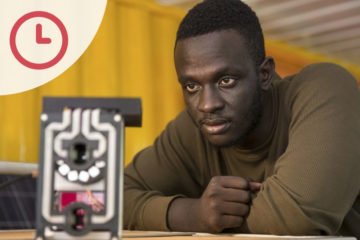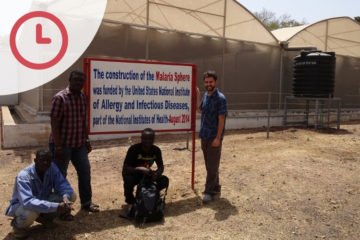Podcast Available on iTunes and Spotify.
Hello, I’m Thomas Locke and this is Five Minutes, the podcast that brings you closer to the people fighting malaria.
Today, I’m joined by Mary Skelly, the CEO of Microbide, a chemical company based in Ireland. Her team is developing a biodegradable insecticide for the control of mosquitoes. It’s currently undergoing so-called ‘bucket trials’ in India.
This is Five Minutes with Mary Skelly.
Mary, thanks for joining me.
Thank you, Thomas.
Tell me more about this new insecticide.
Well, in fact, Microbide Limited is a company that’s focused on developing new disinfectants. We accidentally found that certain of our formulations provided a really interesting biodegradable solution for larviciding for, for example, malarial mosquitoes.
How is your insecticide different from the ones currently available?
The thing that is missing from current products is that they are typically organic phosphates. They are typically not biodegradable and accumulating. We don’t leave the footprint that others do but we effectively kill the early stages of mosquito development.
Why is it significant that this insecticide is biodegradable?
Well, obviously you don’t want residues of chemicals lying around on the Earth or on foodstuffs, animals or on crops because, when that happens, the consumption of those then puts an additional burden on the human or animal that is consuming that – it’s not a good idea. What you really want is something that is sprayed, does the damage and then goes away naturally, developing carbon dioxide and water.
When I was reading up on your work I noticed that you referred to the chemicals you’ve used as ‘old-fashioned chemicals’. What did you mean by that?
The area that we work in are predominantly aldehydes. Aldehydes are very old fashioned, organic compounds. They have three constituents: carbon, hydrogen and oxygen. Aldehydes typically come from fruits and vegetables and so they are natural ingredients, they are found ubiquitously in the environment. As a result, these are very interesting. The reason they have not been used before is that these small organic compounds tend to volatilise off, in other words, they dissipate in the atmosphere very easily. And so in order to use them for, for example, larviciding, you have to reach out and capture them and then use them in such a way that they actually have an effect. Our micellar our technology does just that.
How do you take these naturally occurring chemicals and make them into larvicides that will kill mosquitoes?
Well, what we do is we take the aldehyde, in its natural state it’s an acid. What we do is we raise the PH up to PH neutral so it doesn’t burn anything. In doing that, we actually excite the chemical. So the chemical becomes very energised. When that happens, chemicals typically begin to escape velocity and they go from the liquid into a gaseous situation. What we have done is we’ve used a very simple solution to actually capture these in micelles. Micelles are in our hands, they are typically biodegradable compounds which anchor the aldehydes. They form a lifeboat a life ring around them. Think of it this way: we are the candy coating to M&Ms.
You patented this technology back in 2008. Ten years later, you’re starting your phase two trials. What do those trials entail?
That’s right. There are three stages to the development of a product. The first is laboratory studies. And then there are what’s termed a bucket trial. These are early-stage studies in the field to get a sense of the use of your product in the environment. So in the heat, in the humidity and what you do is you’d actually take laboratory grown non-infected mosquito larvae and you place them into buckets. You go by and you spray the buckets and see what the effect of your compound has been.
Mary Skelly, thank you.
You’re most welcome, Thomas. All the very best.


